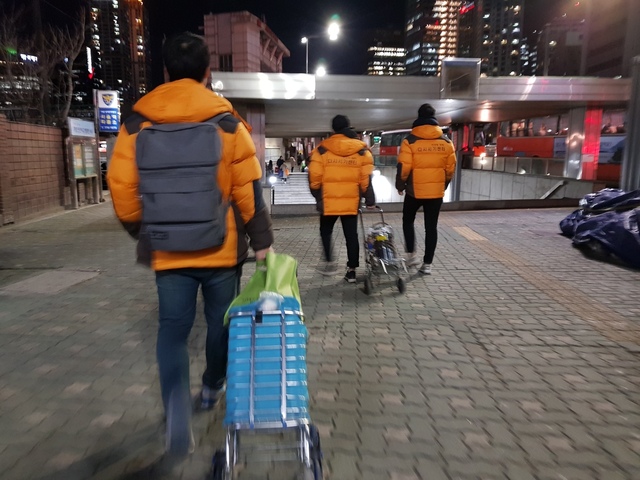Posted on : Dec.17,2017 09:55 KST
 |
|
Outreach counselors Lee Hyeon (30) and Yang Beom-jin (25) speak to a homeless person lying in a cardboard box in Sunhwa Children’s Park in the Jung District of Seoul on Nov. 30. (by Lee Ji-hye, staff reporter)
|
Each night, a team of 11 counselors hit the streets to extend a helping hand to Seoul’s less fortunate
At 7 pm on Nov. 30, 37 homeless people had set up cardboard boxes along the wall of the Namdaemun underpass in the Jung District of Seoul. It was a cold night – the wind chill dropped to -10 Celsius – and they were trying to block, or at least blunt, the bitter wind blowing down the passageway so they could make it through the night.
Threading their way through the vagrants lying down here and there in the underpass were “homeless outreach counselors” wearing yellow blazers. “Aren’t you cold, sir? Would you like a cup of yulmu-cha?” one of them asked, referring to a thick drink made of a grain called Job’s tears. Carrying big thermoses and boxes of hand warmers, the counselors struck up conversation with the vagrants.
The counselors, who each night pay visits to homeless people scattered throughout downtown Seoul, belong to a city support center seeking to help such people get back on their feet. The point of this “outreach” is to extend a helping hand to homeless people who are prevented by shame or disability from visiting the support center on their own.
 |
|
Outreach counselors Lee Hyeon (30) and Yang Beom-jin (25) pull trolleys containing thermoses and hot packs for the homeless outside of the police office at Seoul Station on Nov. 30. (by Lee Ji-hye, staff reporter)
|
Every night, 11 counselors break up into five teams and make the rounds of the main homeless camps near Seoul Station. The counselors urge the homeless to visit a shelter at night so they can at least have a warm place to sleep, and the counselors also give them information about job programs and residential assistance, including halfway houses and nursing homes. When necessary, the counselors also put the homeless in contact with treatment for alcoholism and psychological counseling. I accompanied Lee Hyeon, 30, a social worker, and Yang Beom-jin, 25, a senior majoring in social welfare at Sungkonghoe University, as they went about their evening outreach work from 7:30 pm to 11 pm on Nov. 30.
Along with the Namdaemun underpass, the places the counselors visited that evening included the Namsan entrance underpass and the Seoul Station central underpass. Approximately 70 or 80 homeless people were camped out on this route alone. “Sir, you promised to come out for rehabilitation work, so why weren’t you there? Tonight, at least, you should sleep in ‘the can,’ since it’s so cold out here,” Yang said, tapping one of the cardboard boxes lined up at the Namdaemun underpass. “The can” is the slang term the homeless use for the Hope Support Center at Seoul Station.
“I don’t like that place because there are too many homeless people there,” said a man on the other side of the box. Every day, the counselors meet over 70 homeless people and try to convince them to take advantage of support services, but most days their efforts are in vain. Once again, none of the homeless people responded to the counselors’ urging.
Even so, the program should not be written off as a failure. “In order to build rapport with the homeless, you have to take your time and go slow. Sometimes magic happens, like when this guy who had always been drunk shows up the next day up at a shelter and asks for help finding a job. That’s all made possible by the ongoing outreach work,” Lee said.
What is most concerning for these counselors who interact personally with the homeless are stereotypes about the homeless. “Some people ask the counselors why they’re enabling the homeless lifestyle, but simply moving the homeless out of sight doesn’t solve the problem. It’s important to personally meet homeless people and help them find the will to get back on their own feet,” Lee said.
“It’s particularly important for the outreach counselors to hustle during the winter, since that’s when the homeless are at risk of freezing to death and also when they feel the desire to get off the streets,” said Lee Tae-yong, leader of the street support team at the city’s support center.
By Lee Ji-hye, staff reporter
Please direct questions or comments to [english@hani.co.kr]










